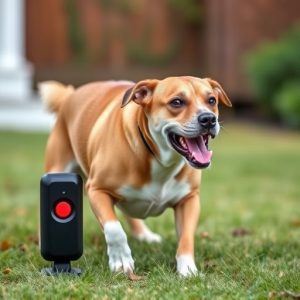Ultrasonic Canine Behavior Modification: Safety, Regulations, and Effectiveness
Canine behavior requires understanding instincts, needs, and emotions for effective training. Positi…….
Canine behavior requires understanding instincts, needs, and emotions for effective training. Positive reinforcement, management, and targeted training address unwanted behaviors like barking or aggression, enhancing the human-dog bond while adhering to regulations like Electronic Pet Deterrent Safety Regulations. Ultrasonic systems, an innovative deterrent, use high-frequency sound waves undetectable to humans but impactful to dogs, guided by safety regulations. Effectiveness varies, so choosing compliant products and consulting professionals is crucial for safe behavior modification.
“Unleash the power of sound to transform canine behavior! This comprehensive guide explores innovative solutions for pet owners seeking to modify their dog’s actions. We delve into the complex world of canine behavior, highlighting the importance of understanding and addressing problematic behaviors. Then, we introduce ultrasonic systems—a non-invasive, electronic pet deterrent that uses high-frequency sound. With a focus on safety and regulations regarding Electronic Pet Deterrent Safety Regulations, this article covers everything from technology fundamentals to practical implementation tips for effective and safe behavior modification.”
- Understanding Canine Behavior and the Need for Modification
- Introduction to Ultrasonic Systems for Pet Deterrents
- Exploring Electronic Pet Deterrents: Safety and Regulations
- How Ultrasonic Technology Works in Behavior Modification
- Considerations for Effective and Safe Implementation of Canine Behavior Modification Systems
Understanding Canine Behavior and the Need for Modification
Canine behavior, much like human behavior, is complex and multifaceted. Understanding a dog’s instincts, needs, and emotional responses is crucial for effective training and modification. Dogs are social animals with strong pack mentality, which means they thrive on structure, routines, and clear leadership. However, their natural behaviors can sometimes conflict with human expectations, leading to challenges in living together harmoniously. For example, barking, biting, aggression, or destructive chewing might stem from fear, anxiety, boredom, or unmet needs rather than malicious intent.
Behavior modification is often necessary to ensure the safety and well-being of both dogs and humans, especially considering Electronic Pet Deterrent Safety Regulations. These regulations aim to protect pets and their owners while promoting humane training methods. By modifying canine behavior through positive reinforcement, management, and targeted training, owners can teach their dogs appropriate responses, prevent unwanted behaviors, and foster a stronger bond based on trust and respect. This process requires patience, consistency, and an understanding of the unique needs and traits of each individual dog.
Introduction to Ultrasonic Systems for Pet Deterrents
Ultrasonic systems have emerged as innovative pet deterrents, offering a non-lethal and humane approach to modifying canine behavior. These electronic pet deterrents emit high-frequency sound waves that are inaudible to humans but can be detected by dogs, triggering a response such as fear or discomfort. The technology leverages the sensitivity of a dog’s hearing, which is far superior to that of humans, allowing for precise and effective training without causing harm.
The safety regulations surrounding electronic pet deterrents, including ultrasonic systems, are stringent to ensure minimal risk to both pets and users. These regulations govern the frequency ranges, power outputs, and design standards to prevent any adverse effects on animal welfare. Understanding and adhering to these guidelines is paramount for responsible use of such devices, ensuring their effectiveness while prioritizing pet safety and well-being.
Exploring Electronic Pet Deterrents: Safety and Regulations
When considering electronic pet deterrents, like ultrasonic systems designed for canine behavior modification, it’s paramount to explore their safety and regulatory aspects. These devices emit high-frequency sound waves that are inaudible to humans but can prompt dogs to alter their behavior. However, their effectiveness and safety vary widely. Some studies suggest they can be effective in modifying certain behaviors without causing harm, but proper use is crucial. The safety of these systems depends on factors such as frequency range, power output, and the dog’s sensitivity to sound.
Regulatory bodies like the FDA and EU have guidelines for electronic pet deterrents to ensure their safety. These regulations mandate specific testing and labeling requirements. Always choose products that comply with these standards to safeguard your pet’s well-being. Additionally, consult with a veterinarian or professional animal behaviorist before implementing any deterrent system to ensure it aligns with your pet’s unique needs and health conditions.
How Ultrasonic Technology Works in Behavior Modification
Ultrasonic technology has emerged as a powerful tool in canine behavior modification, offering a safe and effective way to train pets without causing harm. These systems emit high-frequency sound waves that are inaudible to humans but can be detected by dogs. When a dog exhibits unwanted behavior, such as barking excessively or jumping on people, the ultrasonic device is triggered, emitting a sound that is unpleasant for them. This immediate feedback helps to stop the behavior and teaches the dog what actions are acceptable.
The technology operates under strict Electronic Pet Deterrent Safety Regulations, ensuring it’s humane and well-regulated. The devices are designed to be sensitive, responding only to specific noises or movements, thereby minimizing false triggers. This precision is crucial for effective learning, as it ensures the dog understands the cause of the ultrasonic response, leading to more successful behavior modification over time.
Considerations for Effective and Safe Implementation of Canine Behavior Modification Systems
When implementing a canine behavior modification system, especially those utilizing ultrasonic devices, it’s crucial to prioritize both effectiveness and safety. These systems, designed to correct unwanted behaviors in dogs, should adhere to strict Electronic Pet Deterrent Safety Regulations. The well-being of the animal must be paramount; ultrasonic devices should emit frequencies within safe sound pressure levels to avoid any potential hearing damage or distress.
Additionally, proper training and acclimation periods are essential. Owners or trainers must understand canine sensory perception and how different frequencies affect them. Regular monitoring during sessions is critical to gauge the dog’s reaction and ensure the system operates within safe parameters. Moreover, consistent reinforcement of positive behavior changes through traditional training methods alongside the ultrasonic system will yield better outcomes and foster a stronger bond between pet and trainer.
The integration of canine behavior modification ultrasonic systems offers a modern approach to addressing pet-related issues. By understanding canine behavior and leveraging safe, regulated electronic pet deterrents like ultrasonic technology, owners can effectively manage unwanted behaviors. When implemented with consideration for both effectiveness and safety, these systems have the potential to revolutionize positive pet training methods, fostering healthier and happier relationships between humans and their canine companions. In light of the above, prioritizing proper usage and adherence to Electronic Pet Deterrent Safety Regulations is paramount for successful and responsible behavior modification.


